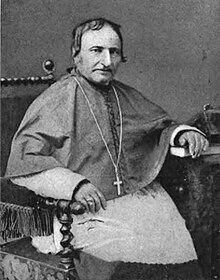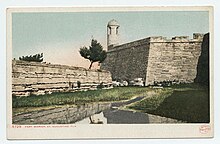| His Excellency, The Most Reverend Jean Marcel Pierre Auguste Vérot | |
|---|---|
| Bishop of St. Augustine | |
 | |
| See | Diocese of St. Augustine |
| Successor | John Moore |
| Previous post(s) | Vicar Apostolic of Florida 1857 to 1870 Bishop of Savannah 1861 to 1870 |
| Orders | |
| Ordination | September 20, 1828 by Hyacinthe-Louis de Quélen |
| Consecration | April 25, 1858 by Francis Kenrick |
| Personal details | |
| Born | May 23, 1805 Le Puy-en-Velay, France |
| Died | June 10, 1876 Saint Augustine, Florida, USA |
| Denomination | Catholic |
Jean Marcel Pierre Auguste Vérot, known commonly as Augustin Vérot (May 1804 – June 10, 1876) was a French-born American prelate of the Catholic Church who served as the first bishop of the Diocese of St. Augustine in Florida (1870–1876).
Vérot previously served as the third bishop of the Diocese of Savannah in Georgia (1861–1870) and as the vicar apostolic of Florida (1857–1870). Bishop Verot High School, a private Catholic institution in Fort Myers, Florida, was named for Vérot in 1964.
Biography
Early life
Augustin Vérot was born on May 23, 1805, in Le Puy-en-Velay in France (then under the rule of the Emperor Napoleon Bonaparte / Napoleon I, in the First French Empire).
He studied at St-Sulpice seminary in Paris.
Vérot was ordained into the priesthood for the Society of Priests of Saint Sulpice by Archbishop Hyacinthe-Louis de Quélen on September 20, 1828. He subsequently joined the Society of Saint-Sulpice and traveled crossing the Atlantic Ocean in 1830, immigrated to the United States, Passing north up into the Chesapeake Bay to the port City of Baltimore, Maryland, largest city in Maryland and then the third largest in America. The Archdiocese of Baltimore was considered the "premier see" of the Catholic Church in the U.S. and its Archbishop of Baltimore was the first to be episcopally ordained in the territory of the newly independent United States of America four decades earlier in 1791. Vérot taught for 23 years in science, philosophy, and theology at the St. Mary's College (founded 1791 in Downtown Baltimore, then located then in its first set (of two, later reconstructed in 1870s) of campus buildings on North Paca Street) and also at its attached theological seminary from 1830 to 1853 (later known and elevated as St. Mary's Seminary and University, greatly expanded when moved in 1929 to expansive Roland Park campus on Roland Avenue and West Northern Parkway / Belvedere Avenue in north Baltimore).
He then was assigned to the outlying town to the southwest and served as pastor of Saint Paul Catholic Church (founded 1838, and one of the then oldest parishes in the archdiocese) in Ellicott's Mills, Maryland (later renamed around that time to Ellicott City, as it became the main town situated on the upper Patapsco River on the eastern edge of the County in the newly-designated county seat of the recently separated jurisdiction of Howard County, Maryland from adjacent older Anne Arundel County further to the east in 1851 (two years earlier before his arrival), as the 22nd and newest of eventually 23 counties in the State of Maryland.
Earlier in 1828, Ellicott Mills / Ellicott City became one of the first destinations and major stop on the new Baltimore and Ohio Railroad, the first passenger and freight railroad in America. then being constructed slowly to the West and the Mississippi River. Father Verot served here for five years from 1853 to 1858.
During his tenure in Ellicott City he was responsible for inviting and securing the arrival of teachers and staff plus support from the Christian Brothers to the nearby Rock Hill College, founded three decades earlier in 1824 as a all-boys boarding school / secondary school in 1853. For decades of the later 19th century it was the only educational institution of higher learning in the County. Rock Hill suffered a disastrous fire a half-century later and closed in 1923.
Vicar Apostolic of Florida
On December 11, 1857, Pope Pius IX appointed Vérot as vicar apostolic of Florida. He was consecrated as Titular Bishop of Danabe on April 25, 1858, by Archbishop Francis Kenrick in the historic old Baltimore Cathedral of the Assumption of the Blessed Virgin Mary on Cathedral Street (between West Franklin and West Mulberry Streets, built 1806–1826, and 1863, designed by famous architect Benjamin Henry Latrobe, 1764–1820).
Since the new vicarate had only three priests, Vérot travelled back across the Atlantic Ocean to France in 1859 to recruit more. It was an extremely different time and country that he returned to compared to the tumultuous times when he left, now under the Second French Empire of the Bonaparte nephew Emperor Napoleon III, 1808–1873, served as president of the Second Republic 1848–1852, reigned 1852–1870). He succeeded however in recruiting and in bringing back an additional seven priests. While in Europe, Vérot also secured additional funding to repair churches further south in the recently admitted new state of Florida (1845) and old earlier Spanish colonial territory in St. Augustine, Jacksonville, and at the southern end of the peninsula in Key West. He erected new churches on the west / Gulf of Mexico coast at Tampa, Fernandina Beach, Palatka, Mandarin, and Tallahassee, and staffed them with resident priests / pastors. Bishop Vérot also built Catholic schools in the vicariate and introduced religious communities to staff them. Five sisters of the Order of Mercy traveled from the further northeastern region of New England in the Diocese of Hartford in Hartford, Connecticut to open a girls' academy / secondary school in Florida. Three Christian Brothers from far northern Canada and Quebec opened a boys' school in St. Augustine.
Bishop of Savannah

On July 13, 1861, Pius IX appointed Vérot as bishop of the Diocese of Savannah. However, he also remained as vicar apostolic of Florida.
During the American Civil War Vérot condemned the looting of the Catholic church at Amelia Island, Florida, by Union Army troops. He personally evacuated several Sisters of Mercy from Jacksonville to Savannah through the battle zone in Georgia. After the war, Vérot published a pastoral letter urging Catholics in the diocese to "put away all prejudice ...against their former servants". He also advocated a national coordinator for evangelization among African-Americans, and brought in French sisters from LePuy to work with them.
Bishop of St. Augustine

On March 11, 1870, Pius IX elevated the Florida vicarate into the Diocese of St. Augustine and named Vérot as its first bishop.
Vérot was among the first public figures to promote St. Augustine, Florida, as a health and cultural resort. He made an annual visitation of the whole diocese, establishing churches and schools. He worked revive the memory of Florida's early martyrs, both Spanish and French.
Vérot's best-known writings are his Pastoral on Slavery and his Catechism. He took a prominent part in the Plenary Council of Baltimore and the First Vatican Council in Rome between 1869 and 1870. At the Council, Vérot called for the condemnation of the heresy that African-Americans had no souls and were not human beings.
Views on slavery

In January 1861, just before the start of the Civil War, Vérot delivered a sermon defending the rights of the slave states and the legal basis of slavery in the United States. He also condemned what he termed the "false and unjust principles of Abolitionism" and the Know-Nothing movement that persecuted Catholics throughout the nation. His sermon was published and distributed throughout the Southern United States as a Confederate tract.
In the same sermon Vérot condemned the international slave trade (consistent with Pope Gregory XVI's decree of 1839). He also called for legal protections for free African-Americans. Verot also wanted enslaved people to be allowed to choose their own marriage partners; to be treated with justice, fairness and morality; to receive adequate food, clothing and shelter; and to be given the means to practice their own religion and to receive instruction in it.
For this sermon, Verot earned the nickname "Rebel Bishop".
See also
- Catholic Church hierarchy
- Catholic Church in the United States
- Historical list of the Catholic bishops of the United States
- List of Catholic bishops of the United States
- Lists of patriarchs, archbishops, and bishops
References
- ^ Zanca, Kenneth J. (1994). American Catholics and Slavery, 1789–1866: An Anthology of Primary Documents. University Press of America. ISBN 978-0-8191-9565-4.
- The Catholic Church in the United States of America Volume III The Province of Baltimore and the Province of New York, Part I. The Catholic Editing Company. 1914. p. 91.
- ^ "Bishop Jean Marcel Pierre Auguste Vérot [Catholic-Hierarchy]". www.catholic-hierarchy.org. Retrieved May 21, 2022.
- Michael V. Gannon, The Cross in the Sand (University of Florida, 1983) pp. 167–168.
- Gannon at pp. 168–169
- Gannon at p. 174
- Cyprian Davis, History of Black Catholics in the United States (New York: Crossroad Publishing Company 1990) p. 119
- John W. O'Malley, Vatican I: The Council and the Making of the Ultramontane Church (Cambridge, MA: Harvard University Press 2018) p. 159
- Gannon, p. 170.
- Gannon at p. 171
External links
- New Advent Encyclopedia entry on Bishop Verot
- Roman Catholic Diocese of Savannah
- Roman Catholic Diocese of St. Augustine
- Story about the death of Bishop Verot on YouTube
Episcopal succession
| Catholic Church titles | ||
|---|---|---|
| Preceded byNone | Bishop of St. Augustine 1857–1876 |
Succeeded byJohn Moore |
| Preceded byJohn Barry | Bishop of Savannah 1861–1870 |
Succeeded byIgnatius Persico |
| Roman Catholic Diocese of St. Augustine | ||
|---|---|---|
| Bishops |  | |
| Churches |
| |
| Education |
| |
| Priests | ||
| Miscellany | ||
